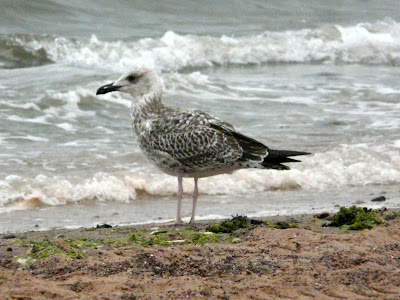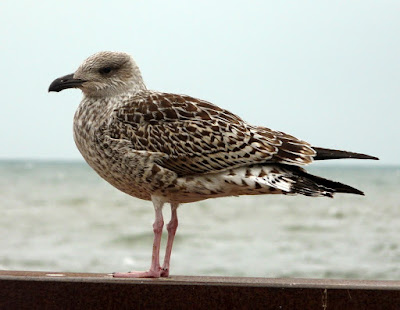Wheatear at dawn on Orcombe Point.
A tiny amount of migrant activity this morning. Just 1 Wheatear and about a dozen Swallows on Orcombe, and 3 Common Sandpipers and a Ringed Plover by the Lifeboat Station. Offshore a handful of Sandwich Terns and 1 or 2 juvenile Mediterranean Gulls. The weather was beautiful.
Around 6pm this evening in murky drizzly conditions, as I was driving along the seafront, I picked up this moulting juvenile Yellow-legged Gull flying low along the beach. I u-turned and quickly relocated it with Herring Gulls on the beach. My initial reaction was one of shock as it dwarfed the accompanying Herring Gulls. It was easily big enough for Great Black-backed Gull but I couldn't reconcile the plumage features for that species. The greater coverts, tertials and tail are all far better for Yellow-legged Gull. Additionally the pattern of the inner greater coverts is a better fit for Yellow-legged Gull. They're not always easy and the later in the season it gets the harder they become!
Note the extent of scapular moult and heavy neck streaking.
Dark-based greater coverts and narrow-fringed tertials not good for GBBG but spot on for YLG.
Pale inner webs and dark outer webs to inner primaries creates a faint 'window' effect.
Right-hand bird - simply massive alongside Herring Gulls and no danger of confusing it with LBBG!
Most scapular feathers have already been replaced with new first-winter feathers.
Of interest, below is a small dark juvenile Great Black-backed Gull that I photographed at the end of August 2014. Note the very pale and openly-patterned greater coverts, the distinctive tertial pattern (showing far more pale than YLG), the 'blob-ended' bill and all juvenile scapular/mantle area. Juveniles often appear much bigger and more pallid than this one.
Juv GBBG










No comments:
Post a Comment